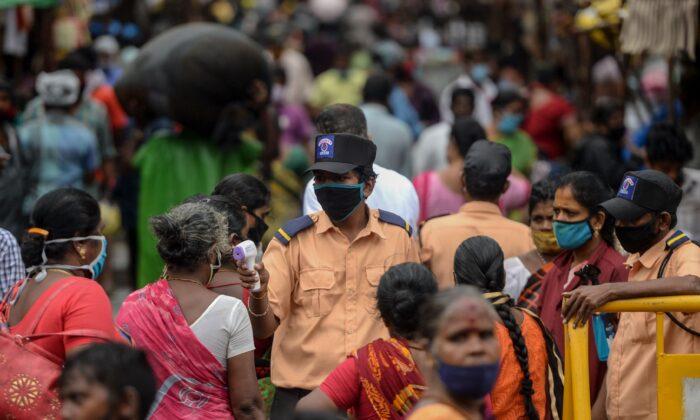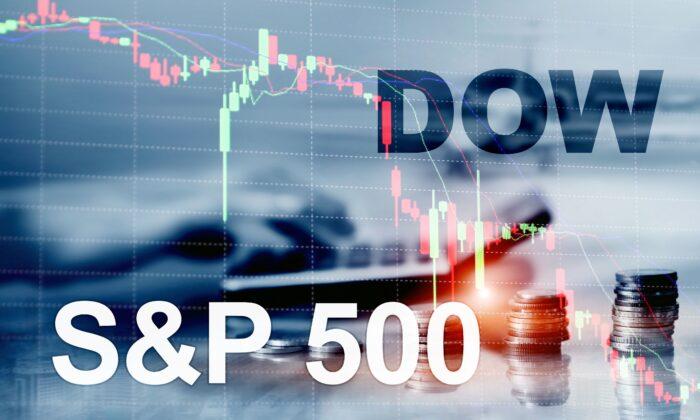NEW DELHI—Surges of new coronavirus cases continued on Aug. 2 in India and the Philippines, which recorded another daily high to surpass 100,000 total infections, as officials across the globe considered stricter measures to stymie the spread of the pandemic.
A curfew was imposed in Australia’s second-largest city, Melbourne, following a spike in infections.
Countries including the United States, India, and South Africa are struggling to rein in their first wave of infections, while South Korea and others where the disease abated try to avert a second wave as curbs on travel and trade ease.
Governments worldwide have reported 684,075 deaths and 17.8 million cases, according to data gathered by Johns Hopkins University.
India’s 54,735 new cases were down from the previous day’s record of 57,118, but raised the total to 1.75 million. The month of July accounted for more than 1.1 million of those cases.
The major cities of New Delhi and Mumbai might have passed their peaks, a government expert, Randeep Guleria, said. Subways, cinemas and other public facilities are closed until Aug. 31.
The Philippines reported 5,032 new cases, raising its total to 103,185, with 2,059 deaths.
On Aug. 1, leaders of Philippine medical organizations appealed to President Rodrigo Duterte to reimpose a lockdown on the capital, Manila. They said the health system was in danger as personnel fall ill or quit due to fear or fatigue.
In Japan, the government reported 1,540 new cases, close to July 31’s record of 1,579.
The spike in infections, most of them in their 20s and 30s, prompted warnings that young people were letting their guard down. Gov. Yuriko Koike of Tokyo, which has about one-third of the new infections, says she might declare an emergency to contain the outbreak.
In Florida, authorities were trying to prepare storm shelters while enforcing social distancing as Tropical Storm Isaias churned toward the heavily populated state.
Florida reported 179 deaths on Aug. 1, raising its total to more than 7,000.
The governor warned residents to expect power outages and said they should have a week’s supply of water and food.
White House coronavirus task force leader Dr. Deborah Birx said Aug. 2 that the virus had entered a “new phase” in the U.S. as it has rapidly spread in rural and urban America.
“What we are seeing today is different from March and April. It is extraordinarily widespread,” Birx told CNN’s “State of the Union” as she urged Americans to wear face masks and observe social distancing measures.
In Australia, Premier Daniel Andrews of the southern state of Victoria announced an 8 p.m.-to-5 a.m. curfew on Melbourne, a city of 5 million people. Schools statewide are to return to home-based teaching and daycare centers were closed.
Andrews said there were seven deaths and 671 new cases since Aug. 1.
“If we don’t make these changes, we’re not going to get through this,” Andrews said.
Also on Aug. 2, South Korea reported more infections but spikes appeared to be tailing off.
Hong Kong reported 125 new infections as authorities tried to find the source of its latest outbreak.
South Korea reported 30 new cases, raising its total to 14,366 with 301 deaths, but said only eight were acquired in the country.
The government warned earlier case numbers would rise as South Koreans came home from the Middle East and other places with outbreaks. Authorities say cases from abroad are less threatening because arrivals are quarantined for two weeks.
On Aug. 1, the leader of a secretive Korean church was arrested in an investigation into whether the group hampered the anti-virus response after thousands of worshippers were infected in February and March.
On Aug. 1, South Africa reported 10,107 new cases, raising its total to 503,290.
In Europe, the number of new cases reported in Italy dipped below 300 for the first time.
Berlin Protests
Thousands protested Germany’s coronavirus restrictions Aug. 1 in a Berlin demonstration marking what organizers called “the end of the pandemic”—a declaration that comes just as authorities are voicing increasing concerns about an uptick in new infections.With few masks insight, a dense crowd marched through downtown Berlin from the Brandenburg Gate.
Protesters who came from across the country held up homemade signs with slogans like “Corona, false alarm,” “We are being forced to wear a muzzle,” “Natural defense instead of vaccination” and “We are the second wave.”
They chanted, “We’re here and we’re loud, because we are being robbed of our freedom!”
Police used bullhorns to chide participants to adhere to social distancing rules and to wear masks, apparently with little success. They tweeted that they drew up a criminal complaint against the rally’s organizer for failing to enforce hygiene rules, then said shortly afterward that the organizer had ended the march.
Police estimated about 17,000 people turned out. The demonstrators were kept apart from counterprotesters, some of whom chanted “Nazis out!”
Protesters continued to a subsequent rally on a boulevard running through the city’s Tiergarten park, which police estimated drew 20,000 people. Police declared that event over as organizers again failed to get demonstrators to wear masks or keep their distance.
Germany’s government has been praised worldwide for its management of the pandemic. The country’s death toll—just over 9,150 people out of more than 210,670 confirmed virus cases as of Aug. 1.
The German government has been easing lockdown measures since late April but social distancing rules remain, as does a requirement to wear masks on public transit and in shops.
Officials have been warning against complacency as the number of new COVID-19 cases has crept up recently. Amid concerns about residents bringing home infections from summer trips abroad, officials introduced free tests for people entering the country.
Germany’s national disease control center registered 955 new cases July 31, a high figure by recent standards.





